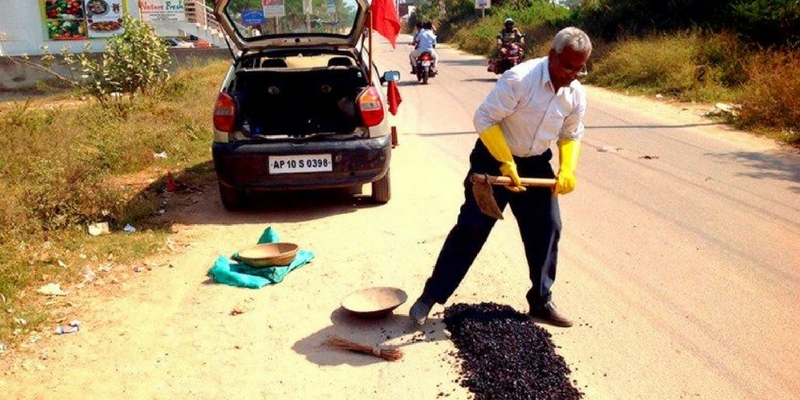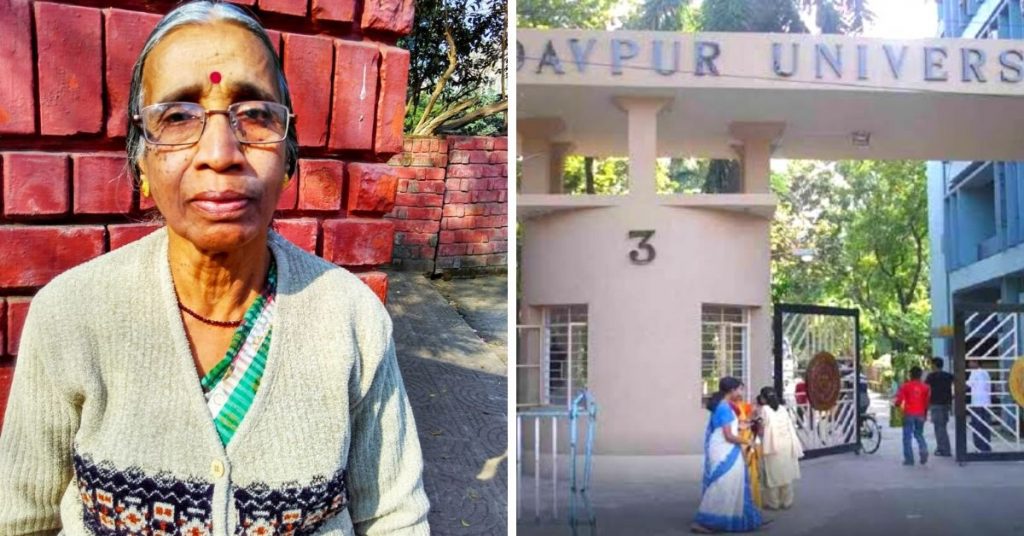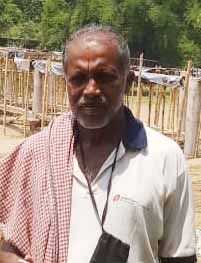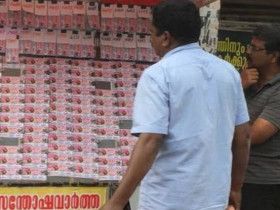No products in the cart.
People who used their Pension funds for Society and set a great example | The Youth
Retired Railways man filled 1,302 potholes in his city with pension money
In a busy world where people have no time to even look after themselves, a retired Railways official is a man on a mission as he is still caring about others’ lives. It is cognisance of the fact that there have been several accidents, deaths due to an increased count of potholes in our country. Though the road contractors and higher authorities are taking time to fix it, Gangadhara Tilak Katnam, who is the owner of a unique pothole ambulance has already filled as many as 1,302 potholes.
He knew that the city roads are not good. So, he decided to repair damaged roads all by himself. Tilak, a South Central Railway engineer, was a consultant at a software firm post-retirement.

“After working for the South Central Railway for 35 years, I retired in October 2008 and spend some time off in 2009, also travelling to the US to meet my son. In January 2010, I came back and settled down in Hydershakote in Hyderabad and took up a job as a consultant in a software agency,” says Tilak, talking about his starting days.
His future initiative started during his job with the software firm. According to a report by The News Minute, “I was driving to my first day of office when I ended up splashing dirty mud water on schoolgoing children after my car fell into a pothole on the road. Then a few more accidents followed at various places.”
Since 2010, Tilak made up his mind to fix the pothole single-handedly without any support from the government. His car is equipped with empty gunny bags, wherein he collects tar lumps from footpaths in a bid to fill potholes with. While plying his trade in the software firm, Tilak often skipped lunch so much so that he could fill the city’s potholes. This sums up the essential Tilak for you!
In an interview with The Times of India, Tilak said, “I celebrated Diwali by filling a pothole. Initially, I used to pick up gravel from the roadside when a new road was being laid. Subsequently, I was not able to find any. I then requested contractors to at least sell me some gravel.”
Despite his son speaking with the commissioner of the Greater Hyderabad Municipal Corporation and his assurance that the higher authorities would take necessary steps to make the much-needed amends, Tilak didn’t relax as he went on to fix any pothole he could find. For doing social work after retirement, the road doctor doesn’t do this for money. He is not accepting any funds or donations for his work.
“I used to spend Rs 25,000 per month but after the GHMC started providing materials, I only spend around Rs 15,000 of my total Rs 20, 000 pension. My son takes care of my household financial needs,” Tilak adds.
Professor saves every single penny and donates Rs.1 crore for Education
Education is the most important requirement in today’s world. In India, there are so many talented children who are deprived of good foundation only because they cannot afford it and it is such a sad sight. On the other hand, Educational institutions make little to no effort in bringing the best out of students because they are always running behind money in a bid to enhance their existing facilities. If and only they could guide the students in the best way possible, we would see countless students achieving great things in life.
Kolkata-based retired professor and former Sanskrit reader identified Chitralekha Mallik knew all these things happening in educational institutes. She also knows how talented children fail to build a foundation just because they lack financial assistance. However, the generous lady Chitralekha Mallik is making sure that children get proper education and thanks to her donation. Her heart-touching acts drew plaudits and gratitude from several educators and students.

In the last 17 years, the 72-year-old woman alone has donated Rs 1 crore to various educational institutions. She could have retired and saved all her income and pensions for her expenses. But she denied to quit her profession and chose to devote herself to this noble cause. Talking about the intention behind her noble gesture, she tells The Better India: “I was in the teaching profession for over four decades, and it is a long enough time to see the harsh side of teaching.
Educational institutions are always yearning for money to improve the existing facilities. It is sad how talented children are deprived of proper platforms only because they cannot afford it. So, I decided to save most of my savings and channelise it towards scholarships and other research-related purposes.”
In 43 years of her fruitful career, she has taught at several Kolkata institutions like Mathabhanga College, and Cooch Behar (1974), College Service Commission (1984), Deshabandhu Girls’ College (1997) and Victoria Institution.
Hailing from Birlapur, which is a small town on the outskirts of Kolkata, Mallik grew up in a humble family with two sisters. Her father worked as a school teacher who believed in principles of sharing knowledge, money or materials to the students who come from the economically backward sections of the society.
Growing up with a highlight on education and simplicity without material comforts, Mallik knew how she wanted to live or lead her life. She dedicated herself to her passion for teaching and for that she did not even marry at all.
Despite receiving a massive pension of Rs 50,000 per month, her 350 square feet house hardly has necessities. She regularly commutes by bus and refuses to hire domestic assistance to save every penny for the welfare of education. She never had the thought of spending money for herself even when it comes to basic needs. She takes clothing from her relatives or rarely goes shopping.
Her first donation of Rs 50,000 made an instant impact on the infrastructural development of Victoria Institution. She adds, “They did not have a proper medical unit inside the campus, and the National Assessment and Accreditation Council (NAAC) was to visit for assessment. They needed to set up a unit to score decent marks.”
Her biggest-ever contribution came in the year 2013 post her retirement. Indian Research Institute for Integrated Medicine in Howrah received a staggering amount of Rs 31 lakh from Mallik in the name of her parents, Radha Ballav Mallik and Shailasudha Mallik.
Then after five years, she made the biggest donation of her life i.e. Rs 56 lakh. She donated this whole amount to Jadavpur University (JU) in the memory of her teacher Pandit Bidhubhusan Bhattacharya.
A senior official from JU confirmed the news and had said, “She (Mallik) is in constant touch with us. She came to the university after puja vacation this year and wanted to know how the fund was being managed.”
The entire amount was divided between research scholarship for a professor and a student. The student scholarship has been allotted for a deserving student in the university and the research one is yet is to be released.
Odisha Man builds a bridge across the river with his pension money
From 0% electrification to the scarcity of water, from no roads to hospitals, so many villages across the nation are suffering from lack of facilities in the household and in the vicinity. Politicians on TV channels claim that they would do anything to transform villages but on the ground level, it is not the same.
The villagers don’t even have a proper bridge across the river these scenarios angered fellow villager Gangadhar Rout, a retired livestock inspector in Odisha village.

While the Salandi in Odisha’s Keonjhar district is known to be a lifeline for so many farmers living on its well-irrigated banks, the lack of a bridge forced residents of Kanpur village-like Gangadhar Rout to row across the water or to walk for hours to reach the destination.
Rout also saw farmers taking long detours on foot to reach their farmlands on the other side of the river.
However, days of delving into disappointment are gone as Rout, the retired man has been firmly dipping into his retirement money to build a 270 foot-long bridge in a bid to connect his village Kanpur to Daneipur across the river.
Unfortunately, for more than a decade, Rout and Kanpur’s villagers had been requesting the state government to build the bridge, but nobody came at the need of the hour as they continued to make do with a temporary bamboo bridge.
Then, a local truck owners’ association and the local MLA invested Rs 3 lakh each to build a proper structure but sadly, it could not be completed. 10 years passed and there was no development since then. So, Rout made up his mind and decided to finish the bridge on his own.
“I thought that if I don’t build it, no one else will,” he said. “My nephew and I had surveyed several bridges in the area to get a good idea and after buying cement, bricks and iron rods, I started in October 2016.”
Those days, Rout thought he could manage to build a bridge within Rs 6 lakh itself. But by the time he erected pillars across the river, he learnt that he had already spent around Rs 10 lakh.
“I almost ran out of money. Luckily, I did not have any small children in my family to look after, so I could spend without thinking much,” he said.
The bridge is even now not complete as it needs seven spans. But Rout is still confident that he can complete the construction once he receives his pension arrears from the government in the next few months.
“With God’s blessings, I hope to complete it within the next two months. I will dedicate it to the memory of two legends of our village, the late Parabasi Rout and the late Pranabandhu Behera. I don’t have much need for money. My two sons are well-settled in life and my daughter is married. I have very few needs,” he said.
Keonjhar district collector named Ashish Thakre assured that the government will help to build approach roads linking to the bridge for the vehicles that Kanpur’s villagers are keen to acquire.
“I did not know about his (Rout’s) efforts. He is indeed a role model for the people of the district,” said Thakre. Villagers hailed Rout as the village hero. “Had he not started building the bridge, it would probably never have been done,” said a villager.
Rout also says he did not receive much assistance from the people of his village at the need of the hour. So, it is a one-man show. “No one came to work, despite my request. They probably thought I would run away with all the fame,” he said.








